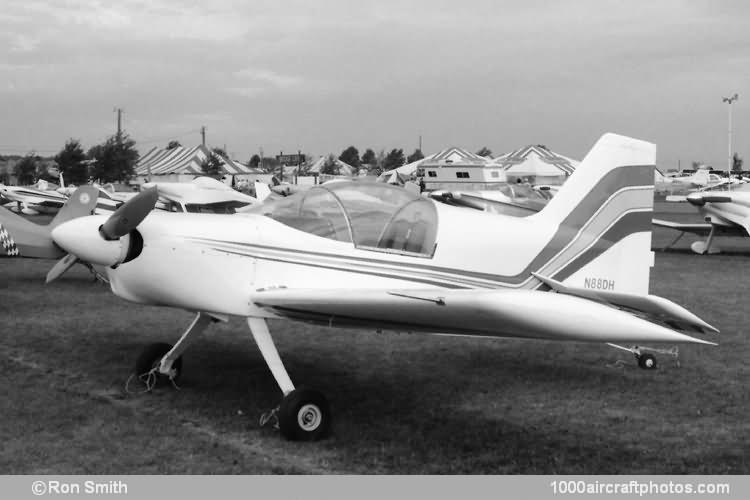The BD-8 development originated in November 1973, and construction of two prototypes began in January 1974; due to the pressure of the BD-5 program, construction of the BD-8 prototypes had not been completed by the time Bede Aircraft went bankrupt in 1977. The first unfinished prototype (c/n 8-001, N8BD) was sold to G.W. Heinlein at the bankruptcy auction in January 1978, soon thereafter it was acquired by homebuilder Mike Huffman, who also acquired the second prototype (c/n 2, N88DH) from Delmar Hostetler, who ran the Bede Aircraft workshop in Harper, Kansas.
Huffman finished the construction of the second prototype (N88DH), including the instrument panel and interior, although did not include the above mentioned improved roll rate feature. Powered by a 200 hp Lycoming IO-360 engine, Huffman made the first flight on May 14, 1980, and in the summer flew the aircraft to Oshkosh where the above shown photo was taken. Two years and some 200 flying hours later, Huffman sold N88DH to Dennis Hayes of Des Moines, Iowa. The aircraft is still registered to Hayes, although the registration has expired a month ago, September 30.
Huffman sold the N8BD project (as he called the first unfinished prototype) to Harold Ellis of Plantation, Florida, it was registered to Ellis on December 6, 1985. Ellis passed away before any work was done, and the project was sold to Ray Ward of Houston, Texas. Ward modified the aircraft extensively, lengthening the fuselage, and installing a 520 hp General Motors Chevy 350 eight-cylinder V-engine with a large four-blade propeller; for propeller ground clearance a tall landing gear was installed. In August 1997 the aircraft was registered as N79RW (c/n 99) and designated Ward Acro (although it was dubbed Super BD-8), and it received a CofA in November 1998.
The aircraft was flown only a few times, by March 25, 2000, it had accumulated a total flight time of 6.1 hours. That day it was substantially damaged during a forced landing following a loss of engine power near its home base Ward Airpark in Beasley, Texas. Upon landing in a field, the aircraft became airborne again, during the second ground contact, the airplane nosed over and came to rest inverted; the aircraft was substantial damaged, Ward sustained only minor injuries. Apparently the aircraft was never repaired, as after Ray Ward passed away on September 17, 2005, the aircraft was deregistered October 31, 2005, as "destroyed".
The following is transcribed from Jane's 1975-1976, five years before a BD-8 flew, hence the weights and performance data (with 200 hp engine) are estimates!"
Type: Single-seat homebuilt sporting aircraft.
Wings: Cantilever low-wing monoplane. Wing section NACA 63.2-015. Incidence 3°. Each wing is built up of glass fiber "panel ribs" which are slid over an extruded aluminum tubular spar, to which they are secured by epoxy resin and large-diameter tube clamps. Each wing section then slides over a smaller-diameter 2024-T3 center section tube. Plain ailerons of light alloy construction are attached to the trailing edges of the ribs. No flaps.
Fuselage: All-metal structure of bolt-together design. Formed 2024-T3 aluminum sections are used for the basic structure of the fuselage. Simple metal gussets are used to form joints, bolted together with bolts and flush screws and lock nuts. Skin of either aluminum sheet or glass fiber panels pop-riveted or bonded to the primary structure.
Tail unit: Cantilever light alloy structure. All-moving tail plane, with combination trim tab and anti-servo tab.
Landing gear: Non-retractable tail wheel type. Main wheels carried on cantilever glass fiber struts. Hydraulic brakes.
Power plant: One Lycoming engine of 180 or 200 hp, driving a two-blade constant-speed tractor propeller. Fuel tanks in wings, with combined capacity of 50 gal (189 l). Refueling points in upper surface of wings. Oil capacity 2 gal (7.6 l).
Accommodation: Single seat beneath upward-opening transparent cockpit canopy. Baggage space aft of seat. Accommodation heated and ventilated.
Systems: Hydraulic system for brakes only. Electrical system powered by engine-driven generator.
